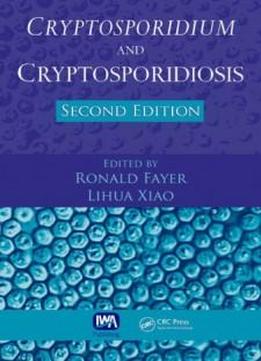
Cryptosporidium And Cryptosporidiosis, Second Edition
by Ronald Fayer /
2007 / English / PDF
14.5 MB Download
From the microscopic observation of infection to the widespread application of molecular techniques in taxonomy and epidemiology, to the genome sequencing of two major species and advances in biochemistry, phylogeny, and water treatment, new information on this fascinating genus continues to mount as we discover and utilize the latest scientific techniques and methods. Greatly revised and expanded to encompass the volume and scope of new material, this second edition of a highly acclaimed reference provides a comprehensive and up-to-date consolidation of data.
From the microscopic observation of infection to the widespread application of molecular techniques in taxonomy and epidemiology, to the genome sequencing of two major species and advances in biochemistry, phylogeny, and water treatment, new information on this fascinating genus continues to mount as we discover and utilize the latest scientific techniques and methods. Greatly revised and expanded to encompass the volume and scope of new material, this second edition of a highly acclaimed reference provides a comprehensive and up-to-date consolidation of data.Continuing to be the seminal work in the field,
Continuing to be the seminal work in the field,Cryptosporidium
Cryptosporidium and Cryptosporidiosis, Second Edition
and Cryptosporidiosis, Second Edition covers every aspect involved in the study of these highly adaptable parasites from basic biology to the search for a vaccine. It introduces molecular biology by discussing recent discoveries in the genome, genetic regulation, and comparative genomics of several species. Contributions present new biochemical data including metabolism and the investigation of structural proteins as potential drug targets. The book details transmission dynamics and molecular epidemiology, molecular methods for detecting infection, sources of contamination in foodborne transmission, and outbreaks and governmental regulations concerning drinking water, recreational waters, and waste management.
covers every aspect involved in the study of these highly adaptable parasites from basic biology to the search for a vaccine. It introduces molecular biology by discussing recent discoveries in the genome, genetic regulation, and comparative genomics of several species. Contributions present new biochemical data including metabolism and the investigation of structural proteins as potential drug targets. The book details transmission dynamics and molecular epidemiology, molecular methods for detecting infection, sources of contamination in foodborne transmission, and outbreaks and governmental regulations concerning drinking water, recreational waters, and waste management.Chapters consider host immune responses, the histopathology and pathophysiology of infection in immunocompetent and immunocompromised humans, and the vast array of compounds tested for the prophylaxis and treatment of cryptosporidiosis in humans and animals. The specifics of disease presentation address several species including fish, reptiles, birds, wild animals, companion animals, and livestock. The final chapters define appropriate animal models for parasite propagation and research, and describe the cells and media most useful for
Chapters consider host immune responses, the histopathology and pathophysiology of infection in immunocompetent and immunocompromised humans, and the vast array of compounds tested for the prophylaxis and treatment of cryptosporidiosis in humans and animals. The specifics of disease presentation address several species including fish, reptiles, birds, wild animals, companion animals, and livestock. The final chapters define appropriate animal models for parasite propagation and research, and describe the cells and media most useful forin vitro
in vitro techniques.
techniques.











